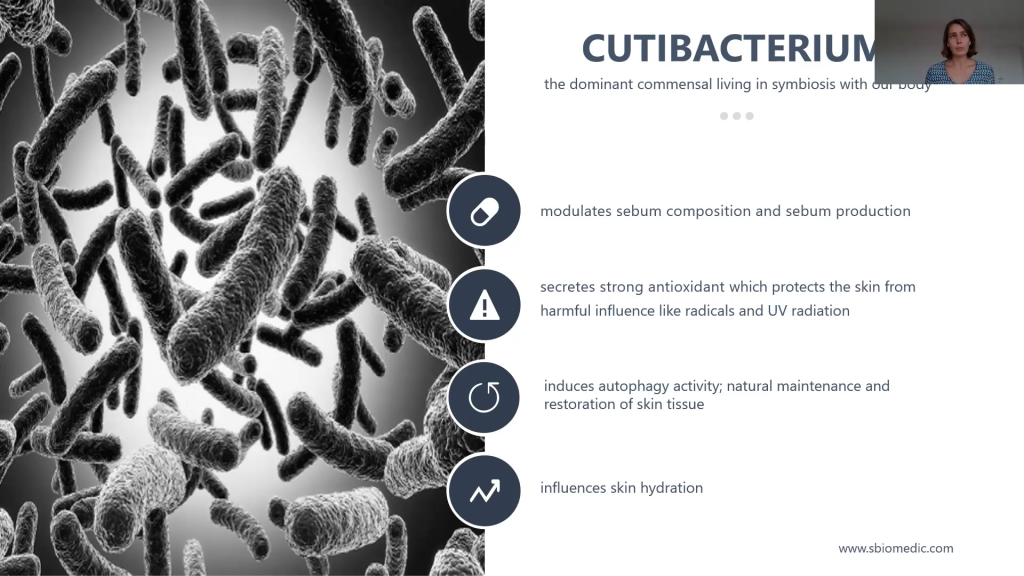Veronica Oudova, CEO and co-founder of S-Biomedic, spoke at the recent Skin Microbiome and Cosmeceuticals Congress
There has been a rapid acceleration of skin microbiome research. Today about 5% of all microbiome clinical studies and 16% of all probiotic products online are dermatology related. Meanwhile, skin probiotics are growing eight times faster than any other probiotic supplement. In clinical cosmetic studies, the microbiome is the fourth largest category.
Veronica Oudova, CEO and co-founder of S-Biomedic, spoke at the recent Skin Microbiome and Cosmeceuticals Congress to discuss how balancing the skin microbiome is a safer and more sustainable approach to lasting skin health.
S-Biomedic is working to show that balancing the skin microbiome is a safe and sustainable approach to creating lasting skin health. The company has filed ten patents to protect its technology, which develops microbiome-based active ingredients that modulate the skin microbiome and establish a healthy equilibrium. Veronica said, “We work at the intersection between the host, the skin microbiome and environmental factors that influence the health of our skin and the composition of the skin microbiome”.
The technology platform looks at the complex interaction between the bacteria and the host and the interplay between different bacteria. It is the first step to developing an active ingredient. The second step enabled by the technology is to explore the different populations found on the body and the dominant species.
“We believe there is a reason why some species are represented much more than others. It is not just by chance, there is a reason for nature to create strong symbiotic relationships”.
Veronica Oudova, CEO and co-founder of S-Biomedic
Cutibacterium
Cutibacterium lives in a niche environment between the hair follicle and the sebaceous glands. Therefore, studying this reduces the complexity of the skin microbiome and allows researchers to focus on the interaction between the dominant common commensal and the host.

Key Cutibacterium characteristics:
1. Different strains of the species have different behaviours: sebum composition, modulation and sebum production modulation.
2. Different strains of Cutibacterium also have different levels of antioxidant activity to protect their hosts from UV radiation, pollution, or any other oxidative stress.
3. The induction of autophagic activity means natural maintenance and restoration of skin cells and tissue.
4. Importantly for the cosmetic industry is their influence on skin hydration.
Understanding these features and functions makes it possible to produce live probiotics with specific strains of good bacteria and to create prebiotics for the skin to influence beneficial strengths.
Acne
Acne is a multifactorial disease and one of the causes can be perturbed microbial composition and activity Most of the treatments today are antibiotics or disinfectants focusing on the reduction of the bacterial count. However, what happens when the bacterial count is reduced, and the treatment is stopped? Surviving bacteria have the first opportunity to repopulate, raising issues of bacterial resistance and problems associated with harsh treatments in skin diseases.
After a degree of pre-treatment or cleansing, the application of live probiotics, or the metabolites of these probiotics, can avoid this by reintroducing some diversity, beyond the surviving bacteria, more quickly.
Aging
In terms of ageing, the potential is to develop many anti-ageing products. There are significantly higher amounts of Cutibacteria on younger skin, which decline over time. With more of the bacteria, there is much stronger autophagic activity and antioxidant activity. These factors together make it possible to think of Cutibacterium as a “new engine” that builds on natural, symbiotic activities to impact skin ageing.
Veronica Oudova, CEO and co-founder of S-Biomedic was speaking at a recent Skin Microbiome and Cosmeceuticals Congress.





